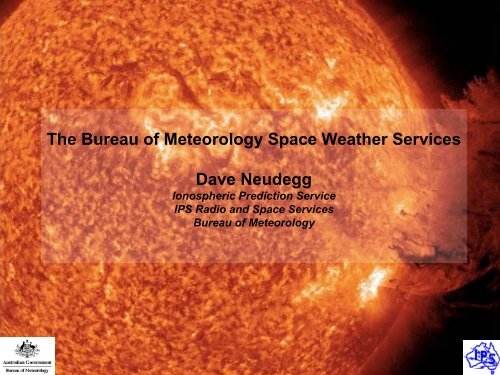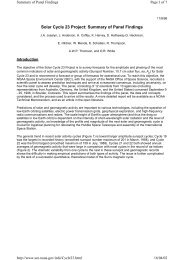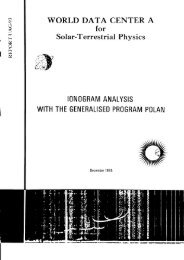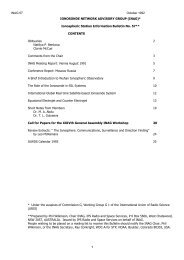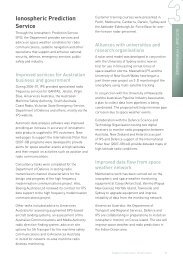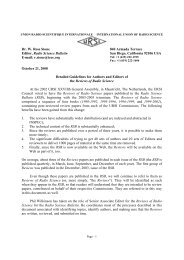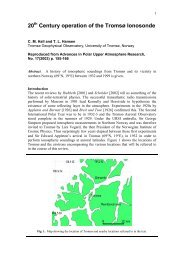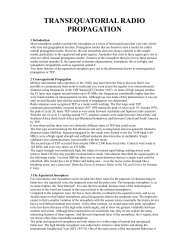IPS presentation - IPS - Radio and Space Services
IPS presentation - IPS - Radio and Space Services
IPS presentation - IPS - Radio and Space Services
You also want an ePaper? Increase the reach of your titles
YUMPU automatically turns print PDFs into web optimized ePapers that Google loves.
The Bureau of Meteorology <strong>Space</strong> Weather <strong>Services</strong><br />
Dave Neudegg<br />
Ionospheric Prediction Service<br />
<strong>IPS</strong> <strong>Radio</strong> <strong>and</strong> <strong>Space</strong> <strong>Services</strong><br />
Bureau of Meteorology
What is “<strong>Space</strong> Weather”<br />
1. System planning with historical data<br />
2. Real-time conditions<br />
“<strong>Space</strong> Weather”<br />
Geo-effective<br />
<strong>Space</strong> Physics<br />
•Sun<br />
• Heliosphere<br />
• Solar wind – IMF<br />
•Cosmic Rays<br />
• Magnetosphere<br />
• Ionosphere<br />
• space debris<br />
• Thermosphere<br />
Technology<br />
• Communications<br />
• Navigation<br />
• Energy transfer infrastructure<br />
• Surveillance<br />
• Aviation - biological<br />
Systems affected that;<br />
• Have a component in space above 100km<br />
• Use radio communication through the ionised atmosphere<br />
• Have a ground based component susceptible to magnetic<br />
or electric variations
www.ips.gov.au/<strong>Space</strong>_Weather<br />
Solar<br />
Geomagnetic<br />
High-Frequency radio<br />
Ionosphere<br />
TEC-GPS
Monthly<br />
Several million hits from<br />
hundreds of thous<strong>and</strong>s of sites in<br />
tens of thous<strong>and</strong>s of visits.<br />
AR1302<br />
Generally follows solar activity<br />
Hourly<br />
International visitors keep<br />
24 hour variation less than<br />
if only national.
ASFC - Australian <strong>Space</strong> Forecast Centre<br />
Solar<br />
Geomagnetic<br />
Ionosphere<br />
Software upgrade<br />
underway by<br />
- Andrew Kelly<br />
- Graham Steward<br />
- Garth Paterson<br />
27 day recurrence
Customers<br />
Type<br />
• HF radio users<br />
– Communications<br />
– Surveillance :radar <strong>and</strong> direction<br />
finding<br />
– Broadcasting<br />
– <strong>Radio</strong> communications consultants<br />
– Sales/manufacturers<br />
– Amateurs<br />
• Geophysical <strong>and</strong> space<br />
– Geophysical exploration<br />
– Power systems protection<br />
– Pipeline protection<br />
– Satellite data users (BoM/CSIRO)<br />
<strong>and</strong> operators<br />
• Scientific research organisations<br />
• Regulatory <strong>and</strong> strategic planning<br />
•<br />
Organisations<br />
Commonwealth Govt -<br />
– Defence - HFMOD<br />
– Aviation - Airservices Australia<br />
– Customs<br />
– ACMA<br />
– <strong>Radio</strong> Australia (ABC)<br />
– Maritime (AMSA)<br />
– BoM (maritime weather via HF radio)<br />
State Govt<br />
– Police, Emergency <strong>Services</strong><br />
– Educational<br />
– Universities<br />
Private<br />
– Geophysical, <strong>Radio</strong> systems<br />
engineers <strong>and</strong> operators, amateurs<br />
International <strong>Space</strong> Weather<br />
organisations
3 rd party sensors<br />
Data for the <strong>Services</strong> – Regional ground based sensor network<br />
Magnetometers<br />
- U. Newcastle<br />
- SERC-MAGDAS<br />
-Geoscience Aust<br />
<strong>IPS</strong>NET<br />
Kwajelein <br />
GPS<br />
-Geoscience Aust<br />
Biak <br />
Manus Is <br />
Solar<br />
- USAF Learmonth<br />
LAPAN <br />
Equatorial - II<br />
Antarctica<br />
- AAD<br />
Darwin<br />
Weipa<br />
Willis Is<br />
Cocos Is<br />
Learmonth<br />
Mid-latitude - I<br />
Townsville<br />
Brisbane<br />
Niue<br />
Culgoora<br />
Perth<br />
Sydney<br />
Canberra<br />
Norfolk Is<br />
Hobart<br />
Christchurch<br />
Aiming for more<br />
integration within<br />
BoM observation<br />
network<br />
Polar - III
Solar wind <strong>and</strong> Interplanetary<br />
Magnetic field (IMF)
Measuring the wider environment - <strong>Space</strong> based sensor network<br />
SOHO<br />
– solar images<br />
- Halo CME alerts<br />
GOES<br />
X-rays (SWF)<br />
radiation for METSATS<br />
STEREO-A<br />
CME side view, in-situ Vsw<br />
PROBA<br />
SDO/SOHO backup<br />
L1<br />
ACE – Vsw, IMF Bz, CME shocks<br />
Geostationary<br />
STEREO-B – upcoming ARs,<br />
CME side view, in-situ Vsw<br />
SDO (geosynch)<br />
High res solar images
Culgoora Solar <strong>Radio</strong> Spectrograph upgrade (Nino Bukilic)
Short term ionospheric variability<br />
Possible polar sources for atmospheric gravity<br />
waves <strong>and</strong> associated travelling<br />
ionospheric disturbances (TIDs)<br />
Expect a combination of modes (1), (3) <strong>and</strong> possibly (4)<br />
at the observation radio reflection point.<br />
observation<br />
Sydney radio reflection point<br />
Propagating AGW modes<br />
Upper modes primarily affected by thermosphere<br />
(1) direct wave observed far from thermospheric<br />
source<br />
(2) direct wave seen near source<br />
Lower modes primarily affected by lower atmosphere<br />
(troposphere/stratosphere/mesosphere). Modes occur for<br />
thermospheric source <strong>and</strong> lower atmosphere source such as<br />
a tropospheric cold front [T] or stratospheric jet stream.<br />
(3) Wave ducted between surface <strong>and</strong> large temperature<br />
gradient at mesopause observed far from source<br />
(4) Earth reflected wave close to source<br />
[Neudegg et al, COSPAR 2010]<br />
tropospheric cold front<br />
Davis (polar cusp)<br />
(2)<br />
Casey (polar cap)<br />
(1)<br />
[T]<br />
[P]<br />
(4)<br />
[C] dayside<br />
[S] nightside<br />
(3) (4)<br />
Macquarie Is<br />
(Plasmapause)<br />
(3)<br />
(1)<br />
(3)<br />
Auroral oval<br />
Irirangi<br />
Field-aligned-currents<br />
(FACs) at E-region (100km)<br />
altitudes may be<br />
strong thermospheric<br />
sources for upper modes,<br />
[C] auroral zone R1 FAC<br />
near 14MLT, close to the<br />
dayside polar cusp,<br />
enhanced during merging of<br />
the geomagnetic field <strong>and</strong><br />
IMF.<br />
[S] Substorm current wedge<br />
FAC on the nightside auroral<br />
oval.<br />
[P] FACs along the<br />
plasmapause
(Equatorial)<br />
Regional<br />
Engagement<br />
AOSWA<br />
Asia-Oceania<br />
<strong>Space</strong> Weather<br />
Alliance
HF radio communications<br />
‘bread <strong>and</strong> butter service’ since 1947<br />
SUBJ: <strong>IPS</strong> HF RADIO COMMUNICATIONS WARNING 10/21 ISSUED AT 23/2354Z<br />
OCTOBER 2010 BY THE AUSTRALIAN SPACE FORECAST CENTRE. DEGRADED HF<br />
PROPAGATION CONDITIONS EXPECTED FOR 24 OCTOBER 2010<br />
IF COMMS DIFFICULTIES EXPERIENCED TRY A LOWER FREQUENCY BAND<br />
_____________________________________________________________<br />
HF COMMUNICATIONS FORECAST (AUSTRALIAN/NEW ZEALAND REGION)<br />
FREQUENCY BANDS<br />
T-index MUFs 2 4 6 8 12 16 22 26<br />
_____________________________________________________________<br />
-10 -22% 2 4 6 8 8 12 16 16<br />
foF2<br />
normal<br />
Hourly area prediction of max usable<br />
Frequencies (MUF) HF frequencies<br />
from a Tx site to broadcast area.<br />
depressed
Regional Ionospheric Modelling<br />
• GPS-derived real time ionospheric<br />
monitoring <strong>and</strong> modelling<br />
• Total Electron Content (TEC) from<br />
90km to GPS altitude (25,000km).<br />
• Regional model, using Spherical<br />
Cap Harmonic Analysis (SCHA)<br />
• Improved spatial resolution over<br />
ionosondes<br />
• Forecast capability<br />
• Data assimilation<br />
• Conversion from TEC to foF2 for HF<br />
predictions very complex<br />
[Mike Terkildsen, Zahra Bouya, Matt Francis]
Regional ionospheric modelling :SCHA<br />
m<br />
m<br />
[ g cos( mλ<br />
) h sin( mλ<br />
)]<br />
K max K<br />
m<br />
VTEC(<br />
θ , λ ) P (cosθ<br />
)<br />
+<br />
c<br />
c<br />
= ∑∑<br />
k= 0 m=<br />
0<br />
nk ( m )<br />
c k<br />
c<br />
k<br />
c<br />
00UT IRI SCHA IRI-SCHA (TECU)<br />
• Spherical Cap Harmonic Analysis<br />
(SCHA) for regional model of TEC<br />
• High spatial resolution with less<br />
coefficients than global SHA<br />
05UT<br />
• Expansion stable over small regions,<br />
scalable<br />
• SCHA gives more detail than simple<br />
interpolation (e.g. kriging)<br />
10UT<br />
• Combining SCHA with a model<br />
ionosphere gives even more detail
QC via Kalman filter<br />
Ionospheric pierce points<br />
of GPS signals<br />
Partial TEC sampling<br />
Interpolated TEC map<br />
GPS position error<br />
Monthly median<br />
Total Electron Content (TEC)<br />
In the ionsophere<br />
Disturbances from median
Aviation GPS – GBAS – Ground Based Augmentation system<br />
Spatial de-correlation of ionospheric error component<br />
• Due to ionospheric gradients<br />
GNSS satellite<br />
• Limits the range of validity of the<br />
correction signals<br />
• Reduces accuracy/availability of GBAS<br />
5 observed ionospheric features observed<br />
are associated with anomalous gradients<br />
Satellite<br />
ephemeris<br />
ERRORS<br />
Clock<br />
ERRORS<br />
=<br />
=<br />
Satellite<br />
ephemeris<br />
ERRORS<br />
Clock<br />
ERRORS<br />
Ionosphere<br />
Ionospheric<br />
ERROR<br />
Ionospheric<br />
gradient<br />
Ionospheric<br />
ERROR<br />
Tropospheric<br />
ERROR<br />
Tropospheric<br />
ERROR<br />
Broadcast<br />
CORRECTION<br />
(integrated ERROR)<br />
GBAS ground station<br />
range
Aviation GPS – GBAS – Ground Based Augmentation system<br />
Ionospheric plumes<br />
• Comparable to<br />
ionospheric ‘plumes’<br />
observed over CONUS<br />
• Generally smaller in<br />
magnitude (peak amplitude<br />
of ionospheric delay)<br />
• Smaller ionospheric<br />
gradients<br />
• Significant source of<br />
storm-time ionospheric<br />
variability
Aviation GPS – GBAS – Ground Based Augmentation system<br />
Poleward expansion of equatorial anomaly<br />
• Under super-fountain<br />
conditions, can reach well<br />
down into mid-latitudes<br />
• Sharp boundaries,<br />
commonly found on<br />
poleward edge of fountain<br />
under storm conditions
Geomagnetic<br />
[Richard Marshall]<br />
Raw data<br />
processing<br />
Indices – K, A, pc3<br />
Maps of K, pc3<br />
Dst storm index
Geomagnetically Induced Currents (GICs) in Power<br />
Networks<br />
Increased national<br />
connectivity driven by<br />
• Market Competition<br />
• Robustness to dem<strong>and</strong><br />
BUT longer power lines<br />
means increased<br />
susceptibility to <strong>Space</strong><br />
weather<br />
AEMO<br />
Australian Energy<br />
Market Operator
GICs in Power Networks<br />
Magnetic field<br />
Transformer burnout occurred in<br />
Canada (Hydro-Quebec 1989)<br />
South Africa<br />
New Zeal<strong>and</strong> 2001<br />
Induced current in power grid<br />
Magnetic field<br />
Induced current in power grid<br />
• New Zeal<strong>and</strong> Previously considered safe<br />
due to mid-latitude location<br />
• Prior to 2001 no GIC related faults<br />
recorded<br />
• Fault attributed to premature ageing<br />
• Analogous situation between NZ south<br />
Isl<strong>and</strong> <strong>and</strong> Tasmania
GICs in Power Networks<br />
[Richard Marshall, Liz Smith]<br />
300<br />
GIC Occurrences > 50<br />
200<br />
Cycle 22 Cycle 23<br />
180<br />
250<br />
160<br />
GIC Index<br />
200<br />
150<br />
Peak of geomagnetic activity<br />
on downslope of cycle<br />
140<br />
120<br />
100<br />
80<br />
60<br />
Sunspot Number<br />
100<br />
40<br />
20<br />
50<br />
0<br />
1985 1990 1995<br />
Time<br />
2000 2005 2010<br />
HBT CNB GNA ASP LRM CTA KDU Sunspot
<strong>Space</strong> Weather <strong>and</strong> Aviation<br />
HF radio<br />
Crosspolar Traffic Levels<br />
from 2000 through 2007<br />
number of movements<br />
8000<br />
7000<br />
6000<br />
5000<br />
4000<br />
3000<br />
2000<br />
1000<br />
0<br />
6930<br />
5308<br />
3731<br />
2053<br />
840 776 884<br />
368<br />
2000 2001 2002 2003 2004 2005 2006 2007
Current solar cycle 24<br />
• Fairly low max (Jan 2013) – predict sunspot number = 90<br />
• What it means<br />
– Low solar radiation fluxes (R12, X-ray)<br />
– Low solar particle fluxes (probably; lack of Solar Proton<br />
Events (SEP) )<br />
– High cosmic ray fluxes as low IMF does not divert them<br />
as much<br />
– Fewer geomagnetic storms
Current solar cycle 24
What lower solar activity does<br />
Region<br />
Sun<br />
Solar wind<br />
Cosmic Ray<br />
Likely characteristics for low solar<br />
cycle (R12 < 50)<br />
Fewer active regions, Low number of<br />
sunspots, generally less activity<br />
Lower fluxes (10.7cm <strong>and</strong> all wavelengths)<br />
Fewer flares<br />
Less disturbed<br />
Fewer shocks<br />
Fewer ICME<br />
Less turbulent environment<br />
Increased galactic fluxes<br />
Decreased solar cosmic ray particle fluxes<br />
Issues<br />
Normal coronal hole activity<br />
But possibly more solar particle events (SEP) Ice-core studies suggest several<br />
large SEP events (including Carrington event) occurred near 1900.<br />
Solar wind less disturbed,<br />
Well-established, high speed solar winds<br />
Same high speed solar winds<br />
Better connectivity to Earth<br />
Bad news for astronauts<br />
Maybe deep space issues, Heliopause moves closer to sun<br />
Magnetosphere Fewer substorms Aurora generally near auroral oval; better for aviation<br />
Few killer electron events; better for satellites<br />
Geomagnetic<br />
field<br />
Neutral<br />
atmosphere<br />
(thermosphere)<br />
Lower ionospheric conductivities<br />
Still potential for extreme geomagnetic<br />
events<br />
Less heating of upper atmosphere<br />
Smaller magnetic activity effects<br />
Major storms (1 or 2 per solar cycle) probability probably unchanged<br />
Less satellite drag<br />
More benign environment for LEO<br />
Less debris removal<br />
Ionosphere Less ionisation of upper atmosphere Smaller HF b<strong>and</strong>width is more vulnerable to storms <strong>and</strong> fadeouts; Bad for HF<br />
Bottom-side ionosphere more structured (F1 always present); bad for HF<br />
Less scintillation at low latitudes; Less problems with trans-ionospheric<br />
propagation - better for SATCOM; GPS


